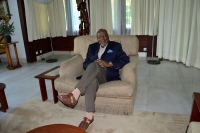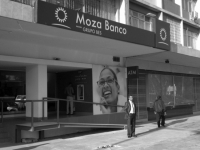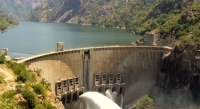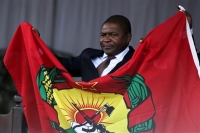Mozambique: Mozambique Outlook for 2014-17
2013/10/10

The country (Mozambique) is situated in Southeastern Africa, bordering the Mozambique Channel, between South Africa and Tanzania.
It has borders with Malawi for 1569km, Swaziland for 105km, Tanzania for 756km, South Africa for 491km, Zambia for 419km and Zimbabwe for 1231km.
Land in Mozambique is mostly coastal lowlands, uplands in center, high plateaus in northwest, mountains in west.
Mozambican land covers an area of 801590 km².
OVERVIEW
The ruling party, Frente de Libertação de Moçambique (Frelimo), will dominate the political landscape in 2013-17, winning national polls in 2014.
The succession to the presidency, currently held by Armando Guebuza, who according to the constitution is serving his final term, will be a contest between his allies and other Frelimo factions. Violence between security forces and Resistência Nacional de Moçambique (Renamo) militia will undermine stability, but widespread conflict is unlikely.
Recent natural resource discoveries support brisk economic increase in Mozambique - an excellent opportunity for the country to tackle its large infrastructural and institutional deficits, and to change its status of a world laggard in human improvment- if the wealth is managed wisely.
Strengths (+) and weaknesses (-)
(+) Generous natural endowment
Large gas reserves, abundant mineral resources, vast agricultural land and a tourism friendly landscape give Mozambique a solid base for economic development and for attracting investments.
(-) Low level of development
Widespread poverty and extremely low development expose Mozambique to a high risk of social unrest. Youth predominance (66% is younger than 25) amplifies this risk. Furthermore, the huge infrastructural deficit and the weak institutions constrain economic and business development.
(-) Economic susceptibility to weather conditions
Weather calamities (that occur often) affect output in agriculture and across the board, through disruptions of transportation and electricity supply. Higher food prices and imports push up inflationary pressures.
(-) Narrow export base
Despite diversification away from aluminum, Mozambican exports are still mainly accounted for by commodities and are therefore susceptible to high volatility in the international markets.
Key developments
1. The mineral and hydrocarbon resources – a blessing or a curse?
Based on recent discoveries of gas (150 trillion cubic feet) and coal (32 billion tons), Mozambique has the potential to become a leading exporter of both products. This potential attracted large amounts of foreign investments. FDI doubled from USD 2.6bn in 2011 to USD 5.2bn in 2012 (37% of GDP), making Mozambique the second major destination for FDI in Africa, next Nigeria. Since these investments were mainly related to project development, huge imports of capital and know how caused the current account deficit to soar to 36% of GDP in 2012, from 24% of GDP in 2011. As a result, the import cover deteriorated to 3.3 months, despite FX reserves having grown steadily in the completed 5 years to USD 2.8bn in 2012. While the higher current account deficit increases reliance on external capital flows, the financing from FDI provides reasonable mitigation against a balance of payments or liquidity crisis. The resource bonanza is as well set to benefit Mozambique in the medium to long term. The IMF estimates that economic increase from coal and gas could add an average of 2ppts per year to GDP in the next decade and that revenues from the sector could make up for 40% of government receipts by 2030.
 Source: EIU
Source: EIU Source: EIU
Source: EIUThe natural resources potential has by presently raised the interest of a lot of, inclunding energy- thirsty Asian nations which are seeking closer ties with Mozambique. The country has by presently benefitted from deficit forgiveness from Japan and Russia, and from windfall tax revenues on sales of stakes in the gas fields as Chinese, Thai and Indian companies joined in or increased their share. However, in the medium term there are several downside risks to Mozambique realizing its potential. Initial, the large infrastructural deficit could hinder developments, as indicated by evolution in the coal sector where transportation is limiting exports way below production capacity and affecting investor interest. Second, inappropriate legislation could have the same impact. While it is positive that Mozambique is overhauling its regulation on gain tax and the hydrocarbon sector to allow for higher local benefits, and that they consult with international organizations on the matter, persistent delays and ambiguities maintain uncertainty and could affect investor confidence. Third, deteriorating world commodity prices could affect the return on planned investments and cause delays or annulations, particularly as new, additional politically mature alternatives such as the United States and Australia come into the picture. Last, protests by local communities could hinder business development, since most of the resources are located in areas where poverty is above the national average and local expectations to benefit from the sectors are high.
2. Changing public deficit structure increases deficit risk profile
Mozambique’s fiscal deficit was 4.2% of GDP in 2012 and it is expected to additional than double to 8.7% of GDP in 2013, pushing public deficit to 42% of GDP in 2012 and to an expected 47% of GDP in 2013. That represents a significant upsurge in the level of public deficit, since it is 50% higher than the 31% of GDP in 2008, next deficit relief. On top of that, the structure has as well changed. Gross donor aid saw a considerable drop, from 13.5% of GDP in 2010 to 8.8% of GDP in 2012, forcing the government to increasingly finance its expenses from additional expensive non-concessional sources, both domestic and international. The external share currently amounts to USD 1.45bn (10% of GDP). The fact that most public deficit is external (86%) and financed by official creditors (69%) provides comfort. But several developments raise concerns about next public deficit sustainability. Initial, while Mozambique’s large infrastructural deficit justifies the capital spending, some recent project choices are questionable (e.g. the debut USD 500m international bond is meant for a fishing fleet with doubtful returns). Hopefully, the close cooperation with the IMF will restrain wasteful spending. Second, though the current appetite for Mozambican sovereign deficit is high, it is motivated by the prospect of next, but from presently on uncertain revenues from the energy and coal sectors. Last, Mozambique’s aid dependency could become a problem for deficit service or roll-over, if current governance concerns cause donors to disrupt assistance. Higher revenues from coal and gas production are expected to provide mitigation, but as mentioned, are from presently on uncertain. All in all, Mozambique’s fiscal metrics remain sound, but it has a higher public deficit risk profile.
3. Political risk increases as conflict between major parties becomes violent
The post-war settlement of 1992 has been the subject of several negotiations between ruling Frelimo and the major opposition party, Renamo. However, recent talks about political inclusiveness - higher representation in the National Electoral Commission and higher economic participation for Renamo - have escalated into violence. Renamo is boycotting coming elections and its army wing has carried out a series of attacks in Sofala province since early 2013. Some of them targeted local but crucial transportation infrastructure, such as the North-South road and the coal export rail line, which affected economic activity through disruptions and deterred investors. Rio Tinto temporarily suspended coal shipments and Russia’s VTB Group cancelled planned investments. The conflict is not expected to escalate into a new civil war or threaten national stability, but attacks will probably intensify locally around the time of the local (2013) and the national (2014) elections.
 Source: EIU, CIA World Factbook, UN, World Economic Forum, Transparency International, Reporters Without Borders, World Bank.
Source: EIU, CIA World Factbook, UN, World Economic Forum, Transparency International, Reporters Without Borders, World Bank.Background information
Mozambique is a South East African country spread along the coast of the Indian Ocean. The country has seen robust economic performances in recent years, on the back of the extractive and energy sectors, which as well represent the principal foreign exchange earners (57% of exports). The services sector accounts for the major share of economic activity, but agriculture provides the lion’s share of employment (78%). The sector is dominated by subsistence farming, despite some diversification towards cash crops in recent years. Trade ties are close with neighbor South Africa- the major trade partner, an significant source of foreign investments and of remittances from Mozambican emigrants. Furthermore, China has become an significant trade partner and source of financial flows. A large infrastructural deficit has created a geographic economic divide in Mozambique, whereby activity is concentrated in the south, while the rest is highly reliant on subsistence farming. The concentration of natural resources in the center and north is set to change this. As indicators in the factsheet indicate, economic benefits have not trickled down. Mozambique is the third least developed country in the world according to the Human Development index. Poverty dispersion reflects the north-south divide, though its level is high nationwide. While freedom of expression is fairly respected, weak institutions allow for high corruption, poor governance and high levels of organized crime.
Weak opposition has allowed the ruling Frelimo to dominate the fairly stable political scene since the end of the civil war in 1992. Opposition parties Renamo and splinter MDM are particularly popular in the center and north. Local elections are stalled for 20 November 2013 and national ones for 2014.

- Related Articles

safewater
2015/11/12 Gal Water Technologies Ltd. is backed by 20 years of experience in supplying water treatment systems for Industrial, Agricultural and Consumable water.
Mozambique’s ex-president Joaquim Chissano talks to PM Communications about the country’s major achievements
2015/09/18 Mozambique’s ex-president Joaquim Chissano talks to PM Communications about the country’s major achievements as it completes its 40th anniversary of independence. He takes the luck to criticize the attitude of Renamo – the major opposition party – as it threatens to return to war for not recognizing the victory of Frelimo in the last elections.
The Mozambique banking sector
2015/07/26 The Mozambique banking sector, which has high increase and good business prospects arising from foreign investment in exploration of natural resources, is attracting the attention of major international banks, according to Eaglestone Securities.
Mozambique is a target country in the internationalisation of China
2015/07/06 Mozambique is a target country in the internationalisation of China Three Gorges and China National Grid and two major hydroelectric projects that are being launched are of interest to these Chinese groups and their Portuguese subsidiaries. Paul Muxanga, chairman of the Cahora Bassa Hydroelectric Dam (HCB), said recently that the long-awaited construction of the northern plant of the Cahora Bassa hydroelectric facility should be initiated any minute at this time, a project which, according to the Portuguese financial daily Diário Económico, is “in the sights” of the two Chinese groups.
Mozambique's ambitious new executive
2015/06/24 Mozambique's ambitious new executive must find ways to bridge a set of gaps: between the core and the periphery; between political parties - established and new; and between the interests of business and the stark fact that Mozambique remains extremely poor, according to a new statement. Recent political developments in Mozambique mark the beginning of an significant era. The party of government, the Mozambique Liberation Front (FRELIMO), is clearly anxious to back the newly elected chief of national, Filipe Nyusi, who - following an initial tussle with his predecessor - is apparently keen to open a different style of dialogue with his rivals both part the country's opposition parties and within FRELIMO itself. This apparent political maturing comes at a time at the same time as the prospect of significant economic transition is gaining ground.
- Mozambique News
-
- DJIBOUTI CITY: East Africa moves to curb used car imports, boost local assembly plants
- CHINA: Support from China for the industrialisation of Angola and Mozambique
- MOZAMBIQUE: Mozambique seeks investors interested in graphite processing in Ancuabe
- MOZAMBIQUE: Mozambique government wants to increase financial inclusion of the population
- BOTSWANA: Routes Africa forum aims to improve African air connectivity
- BOTSWANA: Economic integration is helping boost trade and investment in Africa
- Trending Articles
-
- JAPAN: More of the same from Japanese polls next weekend
- PHILIPPINES: Will services continue to drive the Philippine economy?
- GERMANY: VW says US 'Dieselgate' settlement not to be replicated in Europe
- ISRAEL: Israel's tech boom under threat
- CONGO BRAZZAVILLE: Congo: Total abandons oil field citing decrease in global oil prices
- EUROPEAN UNION: EU meets without Britain for first time since Brexit vote






.gif?1356023993)






